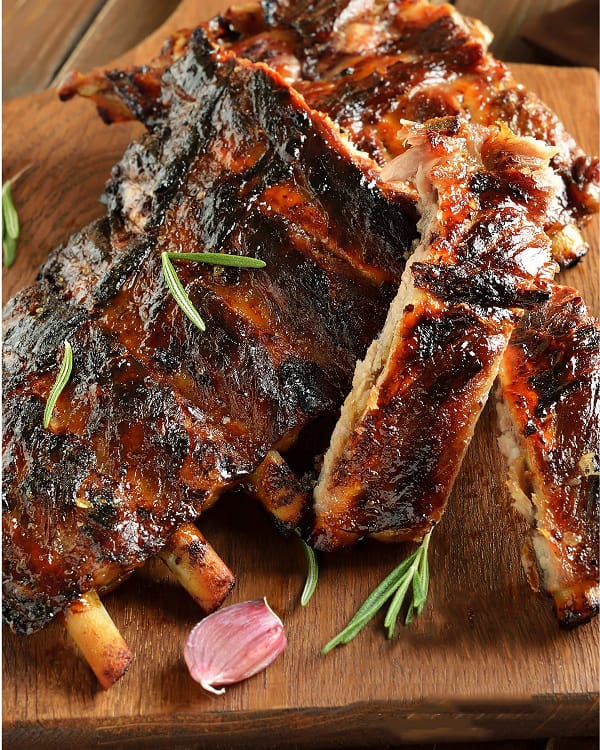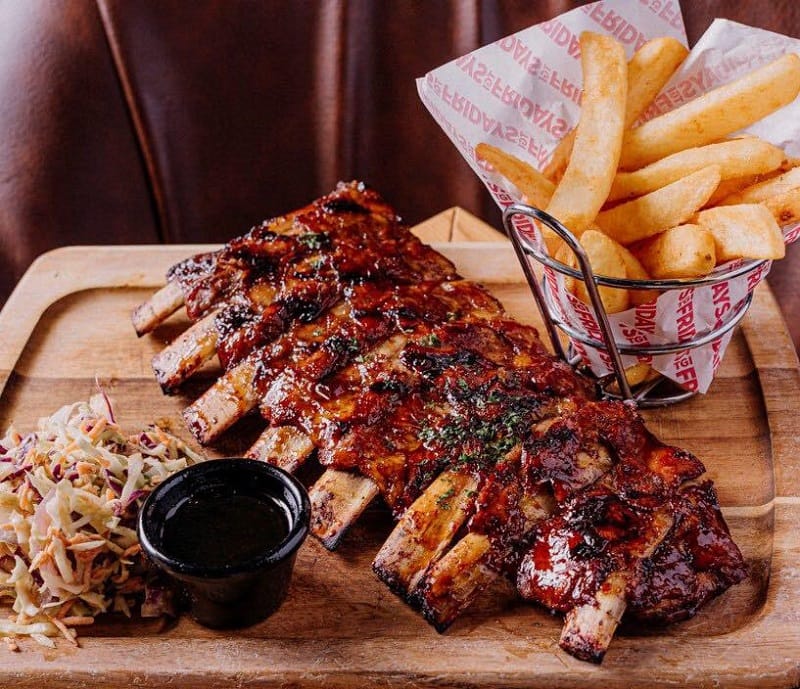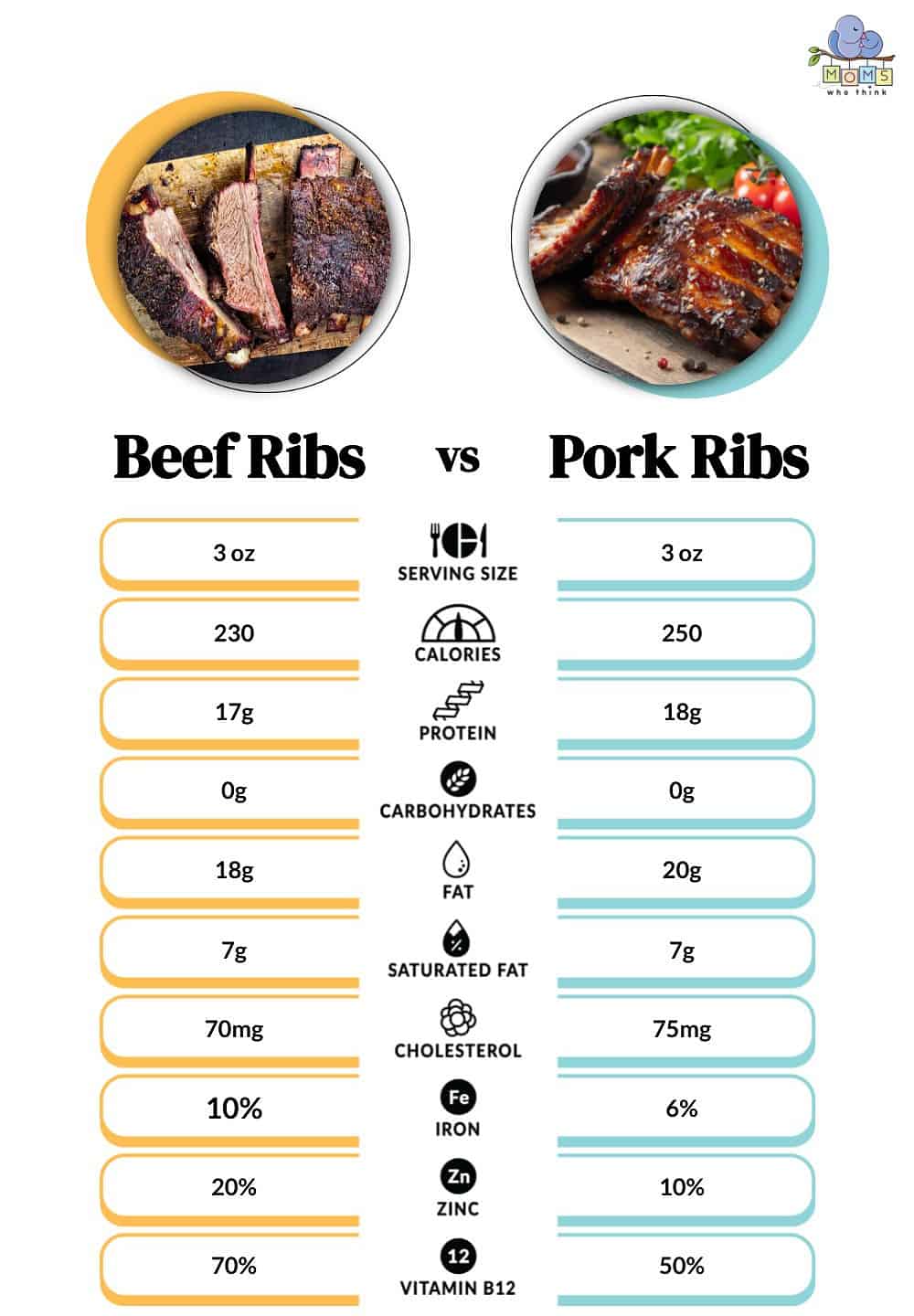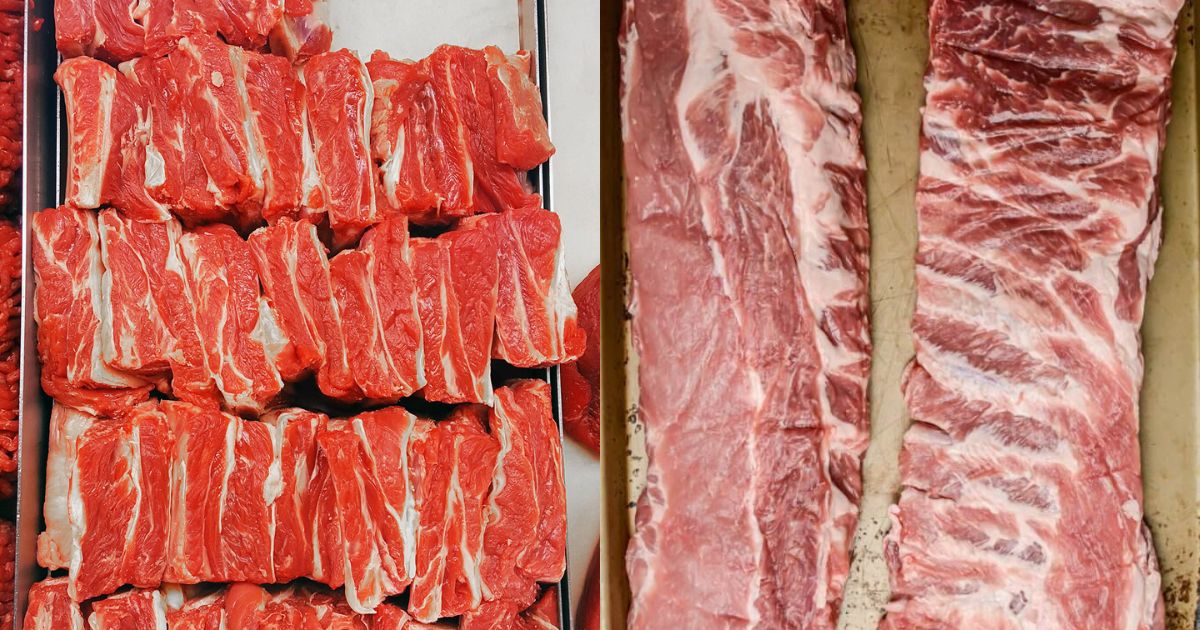Introduction

The battle between beef and pork ribs has long been waged on grills and barbecues across the world. Both cuts offer their own unique flavor profiles and cooking methods, each with its own devoted fan base. Beef ribs are known for their robust and meaty flavor, while pork ribs are prized for their tenderness and juiciness. In this ultimate BBQ showdown, we will explore the differences between beef and pork ribs, from the cuts and cooking methods to the flavor profiles and nutritional values. So grab your apron and get ready to decide which side of the meaty battle you stand on.
Brief Overview Of Beef Ribs And Pork Ribs
Beef ribs and pork ribs are both popular choices for barbecue enthusiasts, each offering its own unique characteristics. Beef ribs are cut from the cow’s rib area and are known for their generous portions of meat, rich flavor, and hearty texture. They can be found in various cuts, such as short ribs or plate ribs. On the other hand, pork ribs are derived from the pig’s rib area and are prized for their tenderness, juiciness, and ability to easily fall off the bone. The most common types of pork ribs are baby back ribs and spare ribs. Both beef and pork ribs are beloved options for grilling and smoking, allowing for delicious and mouthwatering meals.
Beef Ribs
Beef ribs are a meat lover’s delight. These ribs are cut from the rib area of the cow and are known for their generous portions of meat, rich flavor, and hearty texture. They are available in different cuts, such as short ribs or plate ribs. Beef ribs are perfect for those who enjoy a hearty and satisfying meal. They can be cooked using various methods, such as grilling, smoking, or slow cooking, to bring out their full flavor and tenderness. Whether you prefer a smoky and charred taste or a succulent and juicy bite, beef ribs are a delicious choice for any barbecue feast.
Beef Ribs: Cuts And Flavors

Beef ribs come in different cuts, each offering its own unique flavor and texture. One popular cut is the short ribs, which are taken from the plate or rib section of the cow. These ribs are meaty and tender, with a rich beefy flavor. Another cut is the back ribs, also known as beef riblets, which are taken from the upper portion of the cow’s rib cage. These ribs are smaller and more lean, with a slightly milder flavor. Whichever cut you choose, beef ribs are sure to deliver a delicious and satisfying dining experience.
Beef Ribs: Cooking Methods And Tips
When it comes to cooking beef ribs, there are a variety of methods that can help you achieve tender and flavorful results. One popular technique is slow cooking, either in the oven or on a smoker, which allows the ribs to become fall-off-the-bone tender. You can also marinate the ribs overnight to infuse them with additional flavors and tenderize the meat. Another option is braising, where the ribs are seared and then cooked in a liquid, such as broth or wine, until they are tender. Finally, you can also grill beef ribs for a smoky and charred flavor. Whichever method you choose, make sure to season the ribs generously with salt, pepper, and any other desired spices.
Pork Ribs
Pork ribs are a popular choice among BBQ enthusiasts for their tender and flavorful meat. There are two main types of pork ribs: baby back ribs and spare ribs. Baby back ribs are smaller and leaner, with a more delicate flavor, while spare ribs are larger and fattier, resulting in a richer taste. To enhance the taste of pork ribs, many people use marinades and seasonings. Some popular marinades include tangy BBQ sauce, sweet and savory teriyaki, and zesty citrus blends. Whichever marinade you choose, letting the ribs marinate for several hours or overnight will ensure maximum flavor penetration.
Pork Ribs: Baby Back Vs. Spare Ribs

Pork ribs come in two main varieties: baby back ribs and spare ribs. Baby back ribs are smaller and leaner, with meat that is tender and succulent. They are cut from the top of the rib cage, closer to the backbone. On the other hand, spare ribs are larger and fattier, with meat that is more robust in flavor. They come from the lower part of the rib cage and contain more connective tissue, which can result in a chewier texture. Both types of pork ribs are delicious when cooked properly, so it ultimately comes down to personal preference.
Pork Ribs: Marinades And Seasonings
Marinades and seasonings play a crucial role in enhancing the flavor of pork ribs. From tangy and sweet to spicy and smoky, there are endless possibilities to experiment with. Popular marinades for pork ribs include barbecue sauce, soy sauce, honey mustard, and citrus-based concoctions. For added depth of flavor, seasonings like garlic powder, onion powder, paprika, brown sugar, and black pepper can be used. Whether you prefer a classic barbecue flavor or want to explore different taste profiles, marinating and seasoning your pork ribs will take them to the next level of deliciousness.
Beef Vs Pork Ribs
Flavor profile and tenderness are two key factors when comparing beef and pork ribs. Beef ribs are known for their rich, deep flavor, while pork ribs offer a sweeter and more succulent taste. In terms of tenderness, beef ribs tend to be tougher and require longer cooking times to become juicy and tender. On the other hand, pork ribs are naturally more tender and can easily fall off the bone when cooked properly. Ultimately, the choice between beef and pork ribs boils down to personal preference and desired flavor profile.
Flavor Profile And Tenderness Comparison

When it comes to flavor profile and tenderness, beef and pork ribs offer distinct qualities. Beef ribs are known for their rich, robust flavor that is often described as bold and satisfying. The meat of beef ribs is often marbled with fat, which enhances its tenderness. However, beef ribs can be tougher and require longer cooking times to achieve the desired level of juiciness and tenderness.
In contrast, pork ribs have a slightly sweeter and milder flavor compared to beef ribs. They are naturally more tender and can easily fall off the bone when cooked properly. The meat of pork ribs is typically leaner, making them a popular choice for those seeking a lighter option.
Ultimately, the choice between beef and pork ribs comes down to individual preference and desired flavor profile. Whether you prefer the rich and intense flavor of beef ribs or the sweeter and more succulent taste of pork ribs, both options offer a delicious and satisfying BBQ experience.
Nutritional Differences Between Beef And Pork Ribs
When it comes to nutritional content, there are some differences between beef and pork ribs. Beef ribs tend to have higher calories, more protein, and iron compared to pork ribs. This is because beef ribs are larger and have more meat, especially beef short ribs. On the other hand, pork ribs may have a slightly lower calorie count and less protein compared to beef ribs. It’s important to note that the nutritional content can vary depending on the specific cut of ribs and the cooking methods used. As always, it’s important to consider your dietary needs and preferences when choosing between beef and pork ribs.
Cooking Showdown
When it comes to cooking beef and pork ribs, there are two popular methods that go head-to-head: grilling and smoking.
Grilling is a quick and easy way to cook ribs. It involves placing the ribs directly over high heat and searing them to achieve a caramelized crust. This method is perfect if you’re short on time and want juicy and tender ribs in a flash.
On the other hand, smoking ribs takes time and patience. It involves slow cooking the ribs over indirect heat and infusing them with smoky flavor. This method results in a melt-in-your-mouth texture and a rich, robust taste.
Whether you choose to grill or smoke your ribs, make sure to baste them with your favorite marinade or barbecue sauce for added flavor. Serve them up with classic accompaniments like coleslaw, cornbread, and baked beans for the perfect barbecue feast.
Grilling Vs Smoking: Best Methods For Beef And Pork Ribs

When it comes to cooking beef and pork ribs, grilling and smoking are two popular methods that offer distinct flavors and textures.
Grilling involves placing the ribs directly over high heat and searing them to achieve a caramelized crust. It is a quick and easy method that delivers juicy and tender ribs in a flash.
On the other hand, smoking ribs takes time and patience. It involves slow cooking the ribs over indirect heat and infusing them with smoky flavor. This method results in a melt-in-your-mouth texture and a rich, robust taste.
Ultimately, the best method for cooking beef and pork ribs depends on personal preference. Grilling is perfect if you’re short on time, while smoking is ideal for those who enjoy the deep smoky flavors. Don’t forget to baste your ribs with your favorite marinade or barbecue sauce for added flavor.
Serving Suggestions And Accompaniments
When it comes to serving beef and pork ribs, there are plenty of delicious accompaniments that can elevate your meal. For beef ribs, consider serving them with classic BBQ sides such as coleslaw, baked beans, and cornbread. You can also add a tangy barbecue sauce on the side for dipping. For pork ribs, try pairing them with a sweet and spicy barbecue sauce, along with sides like mac and cheese, grilled corn, and potato salad. Don’t forget to include some fresh and crunchy pickles or a refreshing salad to balance out the richness of the ribs. Enjoy your ribs with these tasty accompaniments for a complete and satisfying meal.
Conclusion
In conclusion, when it comes to the battle between beef and pork ribs, both have their unique qualities and flavors to offer. Beef ribs are known for their meaty and robust flavor, while pork ribs are loved for their tenderness and juicy meat. Choosing between the two ultimately depends on personal preference and the desired flavor profile. Whichever you choose, be sure to use the appropriate cooking methods and seasonings to enhance the taste. Explore different cuts, cooking techniques, and accompaniments to create a memorable and delicious rib experience. Enjoy the BBQ showdown and savor every bite.
Final Thoughts On Choosing Between Beef And Pork Ribs

When it comes to choosing between beef and pork ribs, it ultimately boils down to personal preference and desired flavor profile. Beef ribs offer a robust and meaty flavor, perfect for those who enjoy a richer taste. On the other hand, pork ribs are known for their tenderness and slightly sweeter flavor. Consider your own taste preferences, cooking techniques, and desired flavor profile when making your decision. Whichever you choose, be sure to explore different cuts, seasonings, and cooking methods to enhance the taste and create a memorable rib experience.
Recipe Ideas And Final Recommendations
When it comes to exploring the world of beef and pork ribs, the possibilities are endless. Here are a few recipe ideas to inspire your next rib feast:
- Classic BBQ Ribs: Marinate the ribs in a homemade BBQ sauce and slow-cook them on the grill for tender and smoky perfection.
- Asian-inspired Ribs: Try a sticky soy-ginger glaze or a sweet and tangy hoisin sauce for an Asian twist on your ribs.
- Spicy Chipotle Ribs: Add some heat to your ribs with a chipotle rub or sauce for a spicy and smoky kick.
- Citrus-infused Ribs: Use a citrus-based marinade with lemon, lime, or orange zest to add a bright and refreshing flavor to your ribs.
- Mexican-style Ribs: Season your ribs with a blend of chili powder, cumin, and garlic for a bold and savory taste that pairs perfectly with homemade salsa and guacamole.
Regardless of the recipe you choose, the key is to cook the ribs low and slow to ensure tender and juicy results. Don’t forget to baste the ribs with the sauce of your choice during the cooking process for maximum flavor. Pair your ribs with classic sides like coleslaw, cornbread, or mac and cheese for a delectable and satisfying meal. So, grab your apron and get ready to enjoy the mouthwatering battle of beef vs pork ribs!
FAQ About Beef Vs Pork Ribs: Deciding The Meaty Battle
Q: What are the main differences between beef and pork ribs?
A: Beef ribs come from cattle, and pork ribs are from pigs. Beef ribs are typically larger and meatier, while pork ribs are smaller and more tender.
Q: Which type of ribs has a stronger flavor?
A: Beef ribs are known for their rich, meaty flavor, while pork ribs have a sweeter taste. The flavor difference comes from the diet and muscle composition of the animals.
Q: Are beef ribs more expensive than pork ribs?
A: Generally, beef ribs are more expensive than pork ribs due to the cost of raising cattle and the lower yield of meat per animal compared to pigs.
Q: How do cooking methods differ between beef and pork ribs?
A: Beef ribs are often cooked low and slow to break down the tough connective tissues, while pork ribs can be cooked faster due to their naturally tender meat.
Q: Which type of ribs is more popular in barbecue culture?
A: Pork ribs are more commonly used in traditional barbecue styles like Kansas City and Memphis, while beef ribs are favored in Texas-style barbecue known for its emphasis on beef cuts.

Panda Cafe offers delicious dining and takeout to Fairfax, VA.
Panda Cafe is a cornerstone in the Fairfax community and has been recognized for its outstanding Chinese cuisine, excellent service, and friendly staff.